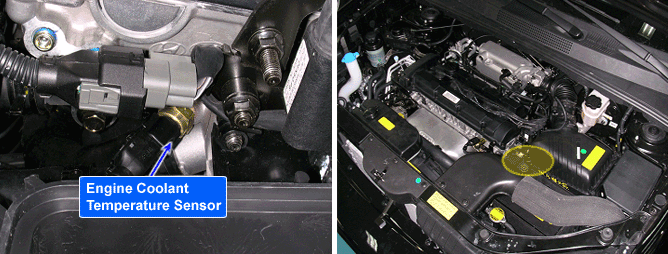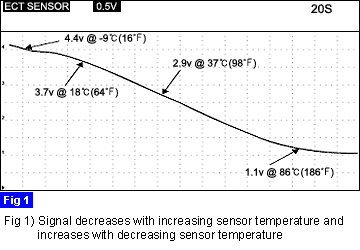

The Engine Coolant Temperature Sensor (ECTS) is located in the engine coolant passage of the cylinder head for detecting the engine coolant temperature. The ECTS uses a thermistor whose resistance changes with the temperature. The electrical resistance of the ECTS decreases as the temperature increases, and increases as the temperature decreases. The reference 5 V in the PCM is supplied to the ECTS via a resistor in the PCM. That is, the resistor in the PCM and the thermistor in the ECTS are connected in series. When the resistance value of the thermistor in the ECTS changes according to the engine coolant temperature, the output voltage also changes.
During cold engine operation the PCM increases the fuel injection duration and controls the ignition timing using the information of engine coolant temperature to avoid engine stalling and improve drivability.
The purpose of this diagnosis is to detect a stuck coolant temperature signal. The diagnostic function checks whether after a variation of the calculated coolant temperature also a variation of the measured coolant temperature is detected.
PCM sets DTC P0116 when the variation of measured engine coolant temperature from engine start is smaller than threshold while variation of calculated coolant temperature by PCM is greater than threshold.
Item | Detecting Condition | Possible Cause |
DTC Strategy | ● Check coolant temperature signal stuck. | ● Contact resistance in connections. ● Faulty ECT sensor. |
Enable Conditions | ● No ECTS failure ● 6 < Battery voltage < 16V | |
Threshold value | ● TCOmodel increase > Threshold But TCOmeas increase <Threshold(Threshold depends on Coolant start temp.) | |
Diagonostic Time | ● 10~30 minutes |
Temp.(°C) | Temp.(°F) | Resistance(kΩ) | Temp.(°C) | Temp.(°F) | Resistance(kΩ) |
-20 | -4 | 14.13~16.83 | 40 | 104 | 1.15 |
0 | 32 | 5.79 | 60 | 140 | 0.59 |
20 | 68 | 2.31~2.59 | 80 | 176 | 0.32 |
